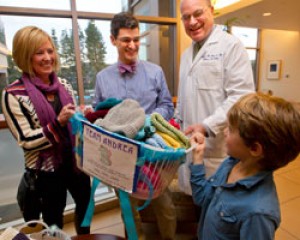Cancer Patient’s Family and Friends Knit Hats Together to Heal and Share Warmth with Others
Cancer Patient’s Family and Friends Knit Hats Together to Heal and Share Warmth with Others

Andrea Fisher’s children and husband presented knitted caps at the Stanford Cancer Center. Left to right: Miles Fisher, 8; Alexander Colevas, MD; Ryan Fisher, 15; Steve Fisher; and Katelyn Fisher, 12.
In a piercing twist of fate, the day that Andrea Fisher’s friends and family began to knit 50 caps for patients at the Stanford Clinical Cancer Center was also the day that doctors there told her there was nothing more they could do to fight the oral cancer that had spread throughout her body.
The news initially stunned Fisher’s friends into silence. Fisher had organized the knitting project as something kids could do–not only her 10- and 12-year-old, but also those belonging to a circle of friends who’d grown closer over the 18 years she fought the disease.
When they heard the news, they sat in silence, said Lisa Pagan, who’d known Fisher since their early 20s. “But at least we had something to do with our hands.”
On Monday, after 18 months of work tinged with mourning, Fisher’s children, Ryan, Katelyn and Miles, along with a small group of her friends and their children, presented the 50 finished caps to Douglas Blayney, MD, the Center’s medical director.

Andrea Fisher’s friend Sharon Thomas, left, and her son Miles, right, present the basket of caps to Alexander Colevas, MD (center left), and Douglas Blayney, MD, Medical Director, Stanford Cancer Center (center right).
Very few of those who stuck with the project knew how to knit; it’s been a challenge to keep things going, said Sharon Thomas, a veteran knitter who volunteered to lead the learning process. Yet the monthly get-togethers at the Green Planet Yarn store in Campbell became part of the healing process, a time when people could talk about Andrea Fisher. “I always kept an eye on Katelyn to see if it was okay to talk about her,” Thomas said. “But she loves to hear stories about her mother and it makes it seem like she’s here again. All of us who got to know each other through her are all still friends. It’s been nice to get together and see each other through that common pain.”
Andrea Fisher was just 42 when she died in May 2010. More than 700 people attended her funeral, said her friend Laurie Weiss. “She touched so many people.”
Fisher, an open water swimmer who learned to surf as an adult, was also a health professional, organizing and expanding a cardiac rehabilitation program at a local hospital. As her illness progressed, she and her friends became fundraisers for oral cancer research, especially that focused on the human papillomaviruses (HPV). Fisher’s cancer was believed to have been caused by an HPV, her friends said.
Fisher’s was slow growing but ultimately invaded her jaw and other parts of her body, triggering a series of surgeries, radiation treatments and chemotherapy regimens.

Andrea Fisher’s family and friends worked for almost two years to knit 50 caps for patients at Stanford Cancer Center.
“We would do the Relay for Life runs,” Pagan said, “but our children were getting to the point where they really wanted to get involved. Andrea came up with this idea to make the caps.”
Knitting scarves is easy, but would have taken too long, Thomas thought. Caps were much more within reach. To keep the project manageable even for the most novice of knitters, Thomas found a pattern that required only the craft’s basic building block, the garter stitch – no purling, no yarn overs, no shaping – repeated until a rectangle was made. By sewing the two short ends together and cinching in one of the other open ends, a very charming hat “with a little poof on top,” Pagan said, blooms into life.
Green Planet made sure the right size of yarn was always in stock, in various hues. “We used every color imaginable,” Thomas said, “and as it turns out, the hats are different sizes.” Experienced knitters are familiar with that variation: Only machines can exert exactly the same amount of stitch tension for row after row of work. It does mean, however, that there’s likely to be a cap for every size of head that needs one.
“Andrea always said she didn’t want to be the poster child for oral cancer,” Weiss said, “but we told her we were going to go out and do everything we could to educate people. There’s not a lot of awareness about it. We feel like it’s our mission in all of this to get the word out, to make sure dentists, for instance, are doing the screening for it.”
“I’m happy we’re finally going through with getting the caps delivered and on to the heads of people I think will really be comforted by them,” Thomas said. But that won’t be the end of it. Many of the knitters, in support of others they know in treatment for cancer, want to continue. Thomas has found an easy pattern for fingerless gloves that she’s teaching Katelyn Fisher to make.
“Andrea was a very special person,” said Pagan. “Our goal from this point on is to try to make something good from all that she had to endure in fighting her cancer.”
By Sara Wykes
Stanford University Medical Center
Photos by Norbert von der Groeben
###
About Stanford Hospital & Clinics
Stanford Hospital & Clinics is known worldwide for advanced treatment of complex disorders in areas such as cardiovascular care, cancer treatment, neurosciences, surgery, and organ transplants. It is currently ranked No. 17 on the U.S. News & World Report’s “America’s Best Hospitals” list and No. 1 in the San Jose Metropolitan area. Stanford Hospital & Clinics is internationally recognized for translating medical breakthroughs into the care of patients. The Stanford University Medical Center is comprised of three world renowned institutions: Stanford Hospital & Clinics, the Stanford University School of Medicine, the oldest medical school in the Western United States, and Lucile Packard Children’s Hospital, an adjacent pediatric and obstetric teaching hospital providing general acute and tertiary care. For more information, visithttp://stanfordhospital.org/
###
* Stanford University Medical Center integrates research, medical education and patient care at its three institutions – Stanford University School of Medicine, Stanford Hospital & Clinics and Lucile Packard Children’s Hospital.
** The above story is adapted from materials provided by Stanford University School of Medicine
________________________________________________________________




















